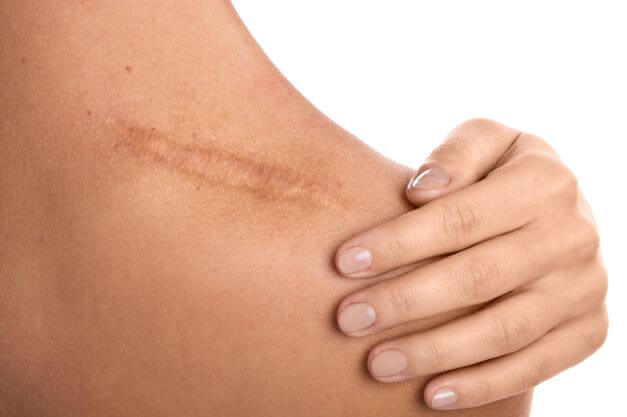Skin surgery, wounds, and scar tissue are common concerns that bring patients in to see their dermatologist. According to Dr. Daniel Condie of U.S. Dermatology Partners in Plano, Grapevine, and Sherman, Texas, “Patients frequently visit me to discuss scar prevention as they undergo surgery and the process of wound healing. While it’s not possible to completely prevent scar formation, there are numerous steps patients can take during wound healing to improve the appearance of scars. Most importantly, they are seeking my help in wound healing, which is an essential step in preventing the formation of unattractive scars.” In this blog, Dr. Condie walks through his top recommendations for scar prevention, the stages of wound healing, and when it’s time to see a dermatologist.
How Wounds & Scars Happen
There are numerous reasons wounds occur, including accidents, injuries, cuts, burns, allergic responses, and bug bites. Wounds may also occur as a result of intentional procedures like surgeries, tattoos, and piercings. Whatever the underlying cause of wounds, unattractive scars can develop if the wound doesn’t heal properly. While anyone can develop a scar after their skin is injured, some factors increase the risk for poor wound healing, including:
- Age – those who are older are more likely to develop scars because they have thinner skin, cells are produced more slowly, and collagen and elastin production is diminished.
- Race – certain ethnicities and races may be more prone to scarring. For example, individuals with dark skin are more likely to develop keloid scars after an injury.
- Health – people with heart disease, diabetes, or poor circulation, are more likely to experience poor wound healing as their immune system is overtaxed from maintaining healthy overall function.
Stages of Wound Healing
Everyone heals differently following a wound. Dr. Condie says, “There are numerous factors that impact the body’s ability to heal, which means no one will take the same amount of time to recover from an injury to their skin, but there are four main phases of healing that should be expected: hemostasis, inflammation, proliferation, and remodeling.” Below, Dr. Condie describes each of these four stages and what to expect:
- Hemostasis – this is the body’s natural response that occurs immediately after a wound. It includes blood clotting, scab formation, and other healing responses.
- Inflammation – as the immune system kicks into gear, inflammation occurs. This may include swelling and redness as the body replaces damaged cells and fights off infection.
- Proliferation – this is the process of creating new skin, blood vessels, and other tissues as the wound closes over.
- Remodeling – this is the final stage of wound healing, at which point, scarring may occur. If the wound was severe enough or other factors were present, the healthy skin may not match the surrounding tissue. This stage may take many months or even a year to complete.
Warning Signs of Improper Wound Healing
According to Dr. Condie, “The most obvious signs that a wound is improperly healing are any symptoms that get worse instead of better with time. If you notice increasing severity of symptoms, it’s essential to contact your dermatologist or other medical professional immediately.” Common signs that a wound is healing improperly include:
- Pain – if pain increases or doesn’t improve within a few days of receiving the wound.
- Bleeding – if the wound continues to bleed after the first 24 to 48 hours, this may be a sign that it isn’t healing as expected.
- Redness – reddened skin around the wound, especially if the redness is spreading, can be an early warning sign of infection.
- Warmth – heat on or around the wound is one of the most common signs of infection.
- Discharge or smell – if the wound produces a discharge or bad smell, this may be indicative of an advanced infection that requires immediate treatment.
Tips to Heal More Quickly
When it comes to the time it takes for wounds to heal, Dr. Condie recommends, “Your body knows how best to heal itself, so it’s important to allow yourself the time you need to heal. However, there are some steps you can take to promote faster, more comfortable wound healing, and minimize scarring. Perhaps the easiest and most obvious is to follow your dermatologist’s aftercare instructions to the letter.” In addition to following aftercare instructions, some other tips to ensure quick and comfortable wound healing include:
- Clean the wound daily – this includes general cleaning like showering or washing your face, and you should also apply any topical ointments or other healing products as directed by your dermatologist.
- Get plenty of rest – our bodies heal and cells regenerate as we sleep, so it’s important to give yourself plenty of rest while your wound is healing.
- Stay hydrated – Proper hydration allows your body’s circulation to deliver oxygen and nutrients to the injured tissue. For that reason, it’s essential to drink plenty of water as you heal.
- Eat a nutrient-rich diet – the vitamins and nutrients in food allow the body to heal and produce new, healthy skin cells. A healthy diet helps with a healthy immune response.
- Avoid harmful substances – smoking, vaping, tobacco in any form, and drinking to excess can impede immune function, slowing down healing and increasing the risk of infection and scarring.
How to Minimize the Risk of Scarring
Scarring is always a possibility after injury, but there are some ways to reduce the risk of unattractive scar tissue formation. According to Dr. Condie, “The best way to optimize scar formation is to follow your dermatologist’s recommended aftercare plan. This should promote healing and prevent discomfort during the healing process. It is important to keep the wound clean during all stages of healing. Initially, I usually recommend a bland ointment such as petrolatum to apply to wounds. After the top layer of skin has healed, sunscreen and minimizing sun exposure are necessary. New skin developed during healing is extremely sensitive to sun damage. Additionally, you may want to incorporate medical-grade silicone gels and/or sheets into your skincare routine. If you want to combine the two treatments, Silagen 100% Pure Silicon +SPF 30 is a great option. It’s an innovative silicon scar-prevention gel with built-in sunscreen. There are many other brands of silicone scar products that also work well.” Below, Dr. Condie goes through some of the top scar prevention dos and don’ts:
- Do – keep the wound clean throughout healing.
- Don’t – skip your moisturizer. Dry skin is prone to scarring and may take longer to heal. Apply petroleum jelly or other protective barrier creams to the wound and protect it with non-stick bandaging.
- Do – massage the wound as directed by your physician. After skin surgery, we typically recommend waiting approximately one month before starting scar massage. You can use a bland ointment, scar gel, or healing serum and massage it into the skin. The massage combined with the hydrating product helps the scar improve during the remodeling phase of wound healing.
- Don’t – spend a lot of time in the sun. We already mentioned this above, but it bears repeating. Sun damage will only worsen scar tissue formation.
- Do – be patient and allow skin the time it needs to heal. You can find countless accelerated healing products or recommendations online, but many of these are not backed by research and may even lead to a worse outcome.
- Don’t – pick just any scar prevention cream. Choose dermatologist-developed treatments like the silicone gel described above.
Scar Removal Options
Despite best efforts to heal skin quickly and minimize scar formation, scarring happens. If you’re concerned about the appearance of scar tissue, Dr. Condie recommends seeing a dermatologist for evaluation and recommendations before starting treatment, even with over-the-counter products. There are several dermatologic products and procedures available for improving the appearance of scars, including:
- Pigmentation correction– for skin discoloration that appears after wound healing, professional bleaching treatments or at-home creams may be a good solution. Cyspera Intensive Pigment Corrector V2 is a skin-lightening product that utilizes safe and effective ingredients to lighten skin. Your dermatologist may recommend other products that have a similar effect.
- Chemical peels – these treatments remove the outer layers of skin to reduce the appearance of discoloration and uneven skin tone or texture.
- Fillers – dermal fillers and soft tissue fillers may be recommended for scarring that causes the skin to cave in. Called atrophic scars, these are common results of acne and chickenpox.
- Laser treatment – can be used to address almost any aspect of skin irregularity that results from scarring, including raised skin, discoloration, uneven tone or texture, and contracture.
- Radiofrequency technology – radiofrequency technology with or without microneedling may be recommended to reduce the appearance of scar tissue and other cosmetic irregularities of the skin.
- Steroids – for raised and contracture scar tissue, injectable corticosteroids can help to reduce the amount of raised and contracted tissue for a smoother appearance.
- Dermabrasion – to improve the appearance and contours of scars, especially following skin surgery. This involves creating a thin wound around the scar and allowing the area to heal inward.
Ready to Talk to a Dermatologist?
If you’re ready to schedule a visit with your dermatologist to develop a skincare plan during wound healing, address issues that arise, and prevent or treat scarring, the U.S. Dermatology Partners team has made it easy. Just take a few minutes to fill out our online scheduling request form. Once our local U.S. Dermatology Partners team hears from you, they’ll reach out to schedule your appointment.
Find a location near me
or


